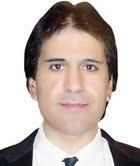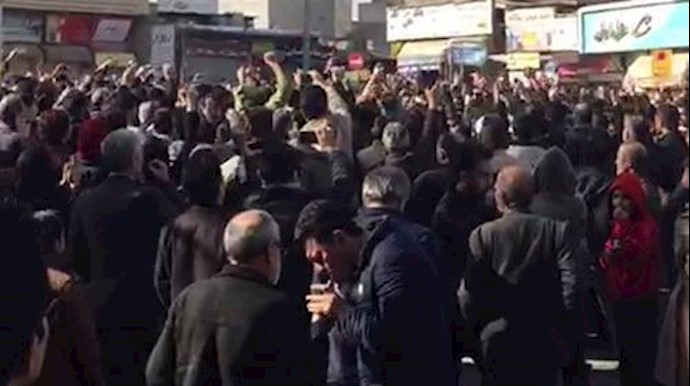Dr. Majid Rafizadeh
Haffington Post, December 28, 2017 – Throughout the day on Thursday, reports emerged from various cities in Iran regarding mass protests against high rates of inflations, rising food prices, and a general trend of economic mismanagement. The primary demonstrations took place in Mashhad, the country’s second most populous city, but others were reported in Neyshabour, Kashmar, Birjand, Shahroud, Noushahr, and Yazd, cities that span from central to north and northeastern Iran.
The latest protests were also reportedly an extension of incidents that had taken place earlier in the week, starting in the city of Isfahan after the announcement that 27,000 workers had been fired due to the recent bankruptcies of a number of firms. Such developments contribute to an economic situation that is dire for much of the Iranian population, in spite of the fact that the 2015 nuclear agreement with six world powers has returned large quantities of frozen assets to the Islamic Republic, as well as bringing new business to a variety of government-linked firms.
This misalignment between the fortunes of the Iranian government and the ordinary population has contributed to the sentiments that were expressed in Thursday’s protests. Many of the thousands of demonstrators blamed government corruption for a significant portion of the hardships they were facing. At times, the crowds were heard to chant, “If you stop one case of embezzlement, our problem will be solved.”
Other slogans specifically named Iranian President Hassan Rouhani, some of them expressing regret at having voted for the supposedly moderate politician, who was elected to a second term in May amidst promises of domestic reform. Little has been done to follow through on those promises, either with regard to economic indicators or the suppression of free speech throughout the country.
Although inflation fell precipitously following Rouhani’s successful pursuit of a nuclear agreement, it has since rebounded slightly. The return to a rate of over 10 percent was widely cited as one of the grievances of Thursday’s protestors, alongside a similar rebound in the official national unemployment rate, to a rate of 12.4 percent.
Also of concern was the vast expenditure of Iranian wealth in foreign conflicts and in the support of terrorist proxies like Lebanon’s Hezbollah. Earlier in December, Rouhani presented the draft budget for the Iranian calendar year spanning from March 2018 to March 2019. It included additional billions of dollars, roughly over $11 billions in allocations to the Iranian Revolutionary Guard Corps, its foreign special operations branch, the Quds Force, and Basij Organization according to the State-run ISNA news agency . Indeed, analyses of the budget identify those entities as major priorities for the Iranian government, including its supposedly moderate president
The National Council of Resistance of Iran released a statement on the latest protests, claiming that they were expressions not only of escalating frustration with economic indicators but also a growing desire for regime change
It quoted the organization’s president, Maryam Rajavi, as saying, “The heroic uprising of today in large parts of Iran has once again proved that the overthrow of the mullahs’ regime and the establishment of democracy and the rule of people is a national and public demand.” Rajavi went on to say that in absence of such regime change, the fortunes of the Iranian people would only continue to decline, due in part to the existing government’s misplaced priorities and institutionalized corruption. “While the overwhelming majority of the people of Iran are suffering from poverty, inflation and unemployment, most of the country’s wealth and revenues is spent on military and security apparatuses and military and regional interventions, or is being looted by the regime leaders or goes into their bank accounts,” she said. The NCRI is a coalition of Iranian resistance groups, most prominent being the People’s Mojahedin Organization of Iran (PMOI/MEK), which is banned by the clerical regime but continues to maintain an intelligence network throughout the country.That network has been largely responsible for the release of information to Western media about Thursday’s protests. In addition to communicating the activities and demands of participating activists, the network has also focused attention on the government’s backlash against the demonstrations, which Iranian officials have evidently tried to conceal.
The governor of Mashhad, Mohammad Rahim Norouzian, told Iranian state media that the police had treated the unannounced gatherings with “great tolerance” and that the only activists arrested were those who had been planning to damage government property.
However, images and video were posted to social media showing security forces firing tear gas and water cannons into crowds of peaceful demonstrators. Some activists were photographed with bloody faces after direct clashes with police.
Throughout Rouhani’s more than four years as president, the Iranian public has reportedly been subject to an escalating crackdown, involving mass arrests of activists, journalists, partygoers, and other advocates of liberal society. Despite this fact, there have been thousands of reported protests in the past year alone, with many of them being described as “anti-government” protests.
hese incidents and the often violent responses of Iranian security forces are still reminiscent of the 2009 Green Movement protests that emerged from disputes over the election in which hardline President Mahmoud Ahmadinejad secured a second term in office. After those nationwide demonstrations were suppressed, its recognized leaders were later placed under indefinite house arrest.
The release of Mir Hossein Mousavi and Mehdi Karroubi was among the most prominent and popular promises made by Mr. Rouhani both during his first presidential campaign in 2013 and his reelection campaign earlier this year. In both instances, Rouhani quickly downplayed those promises upon winning election, leading to widespread condemnation of the president as having turned his back on his supporters. This criticism was certainly raised once again in Thursday’s protests, in the form of chants that criticized the Iranian government for “leaving the people”.

Dr. Majid Rafizadeh is a world-renowned business strategist and advisor, a leading Iranian-American political scientist, president of the International American Council on the Middle East, and best-selling author.








